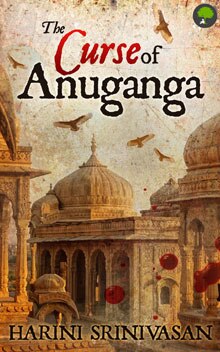
Ex-civil servant, writer and an ex-Editorial Advisor / Consultant to India's Ministry of Information and Broadcasting, Harini Srinivasan latest The Curse of Anuganga (TCOA) sees her foray into historical detective fiction based in the Gupta Era (400 CE). Yogesh Pawar caught up with the author to discuss her book's unusual setting
Not at all. As a part of an activity for a writing group in 2013, I'd written a short story called The Gatekeeper’s Son, a historical detective story set in Nandivardhana during the era known as the Gupta-Vakataka period. That story forms the basis of TCOA. When the news of the excavations of Nandivardhana came out in June, 2018, I was definitely thrilled. The city of my novel, imagined and researched (through books) after all had been found!
 The activity in the writing group that I mentioned was to choose a particular period of Indian history and then write a detective story/mystery set in that period. Since the more popular options (the Mughal period and the British colonial rule and the freedom struggle) were already selected, I had to choose a period from Ancient India. As I read more about the Guptas, Mauryas and other kingdoms, I was fascinated by this period in which the imperial Guptas extended their influence over a large part of the Deccan – not directly but through proxy, through their alliance with the Vakatakas. I thought this offered me much scope as a writer to base a short story (and now a novel) in.
The activity in the writing group that I mentioned was to choose a particular period of Indian history and then write a detective story/mystery set in that period. Since the more popular options (the Mughal period and the British colonial rule and the freedom struggle) were already selected, I had to choose a period from Ancient India. As I read more about the Guptas, Mauryas and other kingdoms, I was fascinated by this period in which the imperial Guptas extended their influence over a large part of the Deccan – not directly but through proxy, through their alliance with the Vakatakas. I thought this offered me much scope as a writer to base a short story (and now a novel) in.
TCOA falls under the genre of historical detective fiction. An element of historical fiction is that it needs to be true to its setting and time period. It needs to transport the reader to the time period (imagined of course to a great extent and aided by books about the period) and stay faithful to the practised mores and customs. In 403 CE, the year in which my novel is based, the predominant religion in India was Hinduism. The book attempts to reconstruct the prevailing social milieu of the period in question. Therefore it reflects the customs and mores prevalent in the families and households of that time.
The Gupta-Vakataka period, an important period in ancient India’s history, provides a backdrop to my story which is more a murder mystery. While the beliefs of the time and the mores do shape how my character behaves and views the world around him, there is no message beyond that. If by way of writing this book, readers are inspired to find out more about forgotten periods of our history, that is a good thing.
To begin with, there was the historical research, I read up as much material as I could find on the Gupta period – both books and research papers. After assimilating the information and getting a sense of the history of the period, the actual writing began. A broad plot outline is what I started with and the key then was to write daily – without fail and develop the story along the outline. Yes, as the writing progressed, I did modify the outline but the story began to take shape. The key thing to writing – any book – is discipline. Creativity improves, newer ideas take shape when one writes daily. For this book, knowing when to stop with the historical research and getting on with writing the story was important!
Strong women are not new to India either in history or now and that despite patriarchy there have been several instances of women rulers who carved out their distinct identities as rulers in their own right, both in military matters as well as social welfare and politics. Doubtless, that Queen Prabhavatigupta was the daughter of the great King Chadragupta II Vikramaditya would have shaped her and made it easier and more natural for her to assume these responsibilities as Regent Queen and would have made the acceptance easier.
Access – no. Research - yes. My being an ex-civil servant definitely helps me to know how to research but it certainly doesn’t give me access to any resources not available to anyone with a computer.
There are some minor stylistic differences in the speeches of the Presidents but what stands out in them is the towering intellect and vast experience of both the statesmen. The speeches reflect the vibrant qualities of nationalism, statesmanship and concern for the lowest of the low and inclusiveness.
The next one is a light, contemporary romantic comedy about a serious young professional who falls for someone she spots in a tacky pan-masala ad!
In the course of my engagement with Publications Division, a unit of the Ministry of Information and Broadcasting, I had the privilege of working on and editing several books such as the Selected Speeches of The President: Pranab Mukherjee; The Republican Ethic: Selected Speeches of Shri Ram Nath Kovind; Abode under the Dome; Indian Classical Dance: Through a Critic’s eye; Legends of Indian Silver Screen to name a few. That was the nature of my engagement and responsibility.